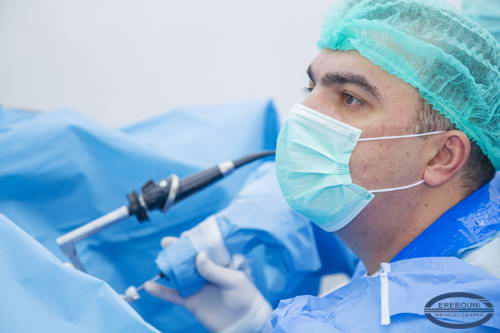One of the most common manifestations of urolithiasis is bladder stones. The symptoms are mainly manifested by the pain in the lower abdomen and suprapubic region, which can be irradiate to the perineum, genitals. The pain occurs when moving and urinating. Another manifestation of bladder stones is frequent urination. Mandatory unreasonable urination desires appears when walking, shaking, or in physical activity. At the time of urination can be noticed so called “obturation” symptom - suddenly the stream of urine is interrupted, though the patient feels that the bladder is not completely emptied, and the urination is restored only after the change of body position. In severe cases, when the stone is very large, the patients can urinate only in lying position.
The most common reason of concernments in bladder is an infravesical obstruction. This is a collective term that includes various pathologies leading to a disturbance of adequate flow of urine from the bladder. It is a violation of free urination, taking place in the area of bladder neck or urination channel, from which suffer the patients, who have the symptoms of presence of concernments in bladder. The mechanism of stone formation is simple: as a result of abnormal changes, the bladder is unable to carry out its functions and properly be emptied, the stagnation of urine in bladder is occurred, the concentration of the urine is increased, the salt crystals are formed, which is in later on stage transforming into stones. In male patients such condition is often leads to prostate hyperplasia, especially in the presence of infravesical growth, also occurs the narrowing of urethra in the prostatic area. Among the patients older than 50 years the frequency combination of prostatic hyperplasia and bladder stones according to different sources is up to 60%.
In the modern medicine the most preferable method of surgical treatment of the patients with bladder stones is considered to be transurethral contact intracorporeal cystolithotripsy.
At the moment the more common are mechanic, pneumatic, electro-hydraulic, ultrasound, electroimpulse and laser methods of contact intracorporeal lithotripsy. The laser lithotripsy method is the most modern method and with the appropriate equipment, can certainly be considered as the method of choice almost in all cases of bladder stones.
A patient G.N., 50-years-old, with bladder stones with diameter 5cm, combined with prostatic hyperplasia, with intravesicle component of 3.0 cm.
In 22.10.15. under the management of the Head of Urology Department prof. M.V.Manukyan (PhD.) was successfully carried out first the contact intracorporeal laser lithotripsy of concernment, and then transurethral resection of the prostate adenoma. In connection with this it should be noted, that in cases of combination of bladder stones with BPH (benign prostatic hypertrophy) or another intravesicle obstructive diseases, intracorporeal lithotripsy shouldn`t be a monotherapy. It is necessary to be able to prevent the cause of obstruction in order to avoid recurrence in the future.
The Clinic of Urology of MC Erebouni, traditionally working and developing at the forefront of medicine in Armenia, along with all necessary up to date urological equipments, is already equipped with laser application for intracorporeal lithotripsy Richard Wolf, which carries out contact intracorporeal laser grinding of concernments at any level of the urinary tracts, including bladder stones.



